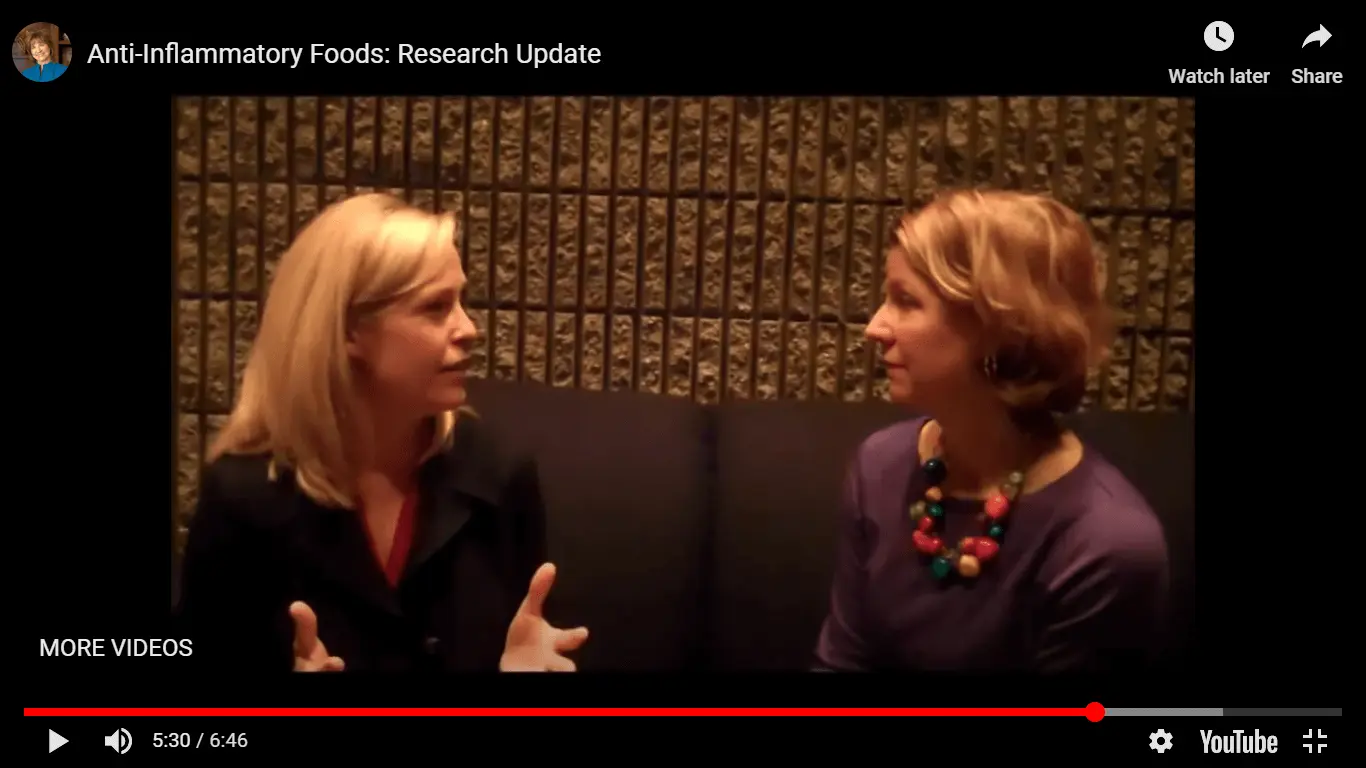
Foods that Fight Inflammation: How to Interpret the Research
Research on how our eating habits may bring anti-inflammatory health protection is now widespread. The problem is that you can read one headline from a study that proclaims “X” food fights inflammation, yet have no idea how that statement fits in the big picture. Is this a food that many studies show –in humans — is anti-inflammatory? Or is it a fluke finding?
In Part 1 of this video series, Susan Steck, PhD, MPH, RD, provided background on inflammation and shared thoughts on how we approach “anti-inflammatory diets”. Here, in Part 2, she discusses some of the foods that came up with strongest and most consistent findings in analysis of worldwide research on diet and inflammation. Dr. Steck is a registered dietitian and Associate Professor of Epidemiology and Biostatistics in the Arnold School of Public Health at the University of South Carolina in Columbia.
Following the video, read on for clarifying details.
Food Choices and Inflammation
- Dietary Fiber ranks among the most anti-inflammatory components of the Dietary Inflammatory Index (DII) that Dr. Steck and her colleagues have developed. Fiber comes in different types, and for now, it’s not clear whether all are equally anti-inflammatory. Some research suggests that for anti-inflammatory effects, fermentable fiber, which the colon’s microbiota (normal health-promoting bacteria) can use, may be key. Butyrate, a short-chain fatty acid produced from this fermentation, seems to nourish colon cells and help maintain the normal barrier in the intestinal wall that blocks absorption of substances that could promote inflammatory reactions.
Tip: Fermentable fiber, including resistant starch, is especially found in pulses (dry beans and peas) and whole grains. Since other types of fiber offer other health benefits, it’s smart to aim for a high-fiber diet that includes a variety of fiber sources, rather than zeroing in on just one.
- Spices, Herbs and Garlic contain phytochemicals (natural plant compounds) that show anti-inflammatory effects consistently enough that several are part of the DII. Turmeric, which contains the compound curcumin, had the highest anti-inflammatory rating among these flavorings. Ginger and garlic were also especially high, and rosemary, thyme, oregano, saffron, pepper and eugenol (the compound found in cloves) earn anti-inflammatory scores in the DII as well. Even as research works out the amounts of these ingredients needed for optimal anti-inflammatory effects, it’s still good news that provides concrete examples of how health-promoting food can be exciting and delicious.
Tip: When cooking with garlic, you can maximize the health-protective compounds you get by chopping or pressing your garlic and letting it sit on the cutting board 10 minutes while you prepare other ingredients. That allows time for the active compound to form before the heat of cooking destroys the necessary enzyme.
- Tea is a strong component of the DII. As Dr. Steck mentioned in our video interview, this includes both green and black tea. The concentration of specific flavonoid compounds differs between the two, but so far, population studies don’t sufficiently differentiate between them.
Tip: Although herbal teas can be delicious caffeine-free, calorie-free beverages, they are not included in the DII score. The score also does not differentiate between regular and decaf versions of green and black tea. EGCG (in green tea) and thearubigins (in black tea) content is substantially lower in decaf than regular forms, but substantial amounts remain.
- Fruits and Vegetables are not identified elements of the DII score, but they are the primary sources of many of the nutrients and phytochemicals that the DII counts as anti-inflammatory.
♦ Beta-carotene (in dark green vegetables, like broccoli and Brussels sprouts, and deep orange produce, like carrots, winter squash, cantaloupe and fresh or dried apricots )
♦ Vitamin C (cauliflower, hot or sweet peppers, kiwifruit, citrus and berries)
♦ Flavonols (onion, apple, spinach and kale are key sources)
♦ Flavonones (look to oranges and grapefruit)
♦ Flavones (found in parsley, artichokes and celery, they’re less abundant but rate very highly on the DII)
♦ Isoflavones (from soy and other legumes)
♦ Flavan-3-ols (most abundant in green and black tea, as well as chocolate and cocoa)
♦ Anthocyanidins (think berries as the all-star sources, and cherries and red cabbage, too)
Tip: What we see from this: we need to step beyond typical American eating habits, which are not only low in vegetable and fruits, but also include a narrow variety. How many different fruits and vegetables do you eat in one week? Keep track over the coming week, and then challenge yourself to raise that number by one or two each week over the next month.
Anti-Inflammatory Compounds vs Foods
As Dr. Steck notes, the key to diet as an anti-inflammatory influence seems to come not from one specific food or nutrient you can eat, and then fill up on random other nutrient-poor junk. An anti-inflammatory diet seems to be the result of how foods with a variety of nutrients and compounds come together.
Omega-6 fat provides a great example of this. Our most concentrated sources of omega-6 polyunsaturated fat are vegetable oils, especially corn, soybean, safflower and cottonseed oils, along with nuts and seeds. Although omega-3 fat (most concentrated in certain coldwater fish, such as salmon, sardines, mackerel and herring) is widely recognized as anti-inflammatory, some sources refer to the other family of PUFA (polyunsaturated fatty acids), omega-6, as pro-inflammatory. However, more recent research does not so clearly support this. As replacements for saturated or trans fat, though not as strongly as omega-3 fats, omega-6 fats help lower markers of inflammation, and do link to lower risk of heart disease.
However, we don’t eat “omega-6 fat” – we eat foods that contain it. If you eat a lot of nuts or salads, the overall impact of your diet is likely healthy. However, if your diet is high in vegetable oils used in commercial bakery, breaded convenience foods and other highly processed foods, the overall impact likely does not promote good health.
Components Together Anti-Inflammatory
The strength of the DII lies in assessing how many aspects of overall eating habits come together.
When the DII was used to score people’s diets:
♦ Each one-unit increase in DII (more inflammatory) was associated with about a 10% increase in risk of elevated C-reactive protein (CRP), a commonly-used marker of inflammation when greater than 3.0 mg/L.
♦ People in the top quarter of DII scores (more inflammatory) were 37% more likely to have elevated CRP than those with lowest scores (most anti-inflammatory) in a large U.S. study that included a diverse population. This relationship was seen after adjusting for a range of factors known to promote inflammation.
Bottom Line: Smart Choices to Fight Inflammation
Evidence is growing in identifying foods that seem to provide anti-inflammatory health benefits. Although individual nutrients and compounds can show anti-inflammatory effects in isolation, it’s important to remember that the net effect will be influenced by the total content of a food. Moreover, the overall impact of eating habits on inflammation is unlikely to relate to any single food, but to how our entire eating choices come together.
To hear Dr. Steck on what she and her colleagues are finding about the link of DII as a representation of the inflammatory effect of diet and health outcomes, please come back for the final portion of our interview. To make sure you don’t miss any of my research updates, sign up to get them direct to your email inbox!
Click here to sign up, and you’ll get a bonus: a free tip sheet with key steps to anti-inflammatory eating habits.
Brahe LK, Astrup A, Larsen LH. Is butyrate the link between diet, intestinal microbiota and obesity-related metabolic diseases? Obesity Reviews 2013; 14(12):950-9.
Kris-Etherton P, Fleming J, Harris WS. The debate about n-6 polyunsaturated fatty acid recommendations for cardiovascular health. J Am Diet Assoc. 2010 Feb;110(2):201-4.
Shivappa N, Steck SE, Hurley TG, et al. A population-based dietary inflammatory index predicts levels of C-reactive protein in the Seasonal Variation of Blood Cholesterol Study (SEASONS). Public Health Nutr. 2014 Aug;17(8):1825-33.
Shivappa N. Dietary Inflammatory Index and Its Relationship with Inflammation, Metabolic Biomarkers and Mortality. (Doctoral dissertation). 2014. Retrieved from http://scholarcommons.sc.edu/etd/2882
3 Comments
Leave a Comment
Published : November 13, 2016 | Last Updated: June 2, 2022
Tagged: Anti-Inflammatory Diet, cancer prevention, dietary fiber, healthy diet, healthy eating, heart health, inflammation, plant-based diet, reducing cancer risk, researcher interviews, Susan Steck, vegetables, video interview
Meet the author/educator
I Take Nutrition Science From Daunting to Doable.™
As a registered dietitian nutritionist, one of the most frequent complaints I hear from people — including health professionals — is that they are overwhelmed by the volume of sometimes-conflicting nutrition information.
I believe that when you turn nutrition from daunting to doable, you can transform people's lives.
Accurately translating nutrition science takes training, time and practice. Dietitians have the essential training and knowledge, but there’s only so much time in a day. I delight in helping them conquer “nutrition overwhelm” so they can feel capable and confident as they help others thrive.
I'm a speaker, writer, and nutrition consultant ... and I welcome you to share or comment on posts as part of this community!



[…] and fruits also provide a wide range of natural compounds called flavonoids that offer the double-quenching power of turning on body antioxidant defenses and acting through other systems directly helpful in […]
[…] and fruits also provide a wide range of natural compounds called flavonoids that offer the double-quenching power of turning on body antioxidant defenses and acting through other systems directly helpful in […]
[…] variety of “anti-inflammatory diets”; in Part 2, she talks about development of an overall Dietary Inflammatory Index (DII) that pulls together inflammatory and anti-inflammatory food consumption into one score meant to […]